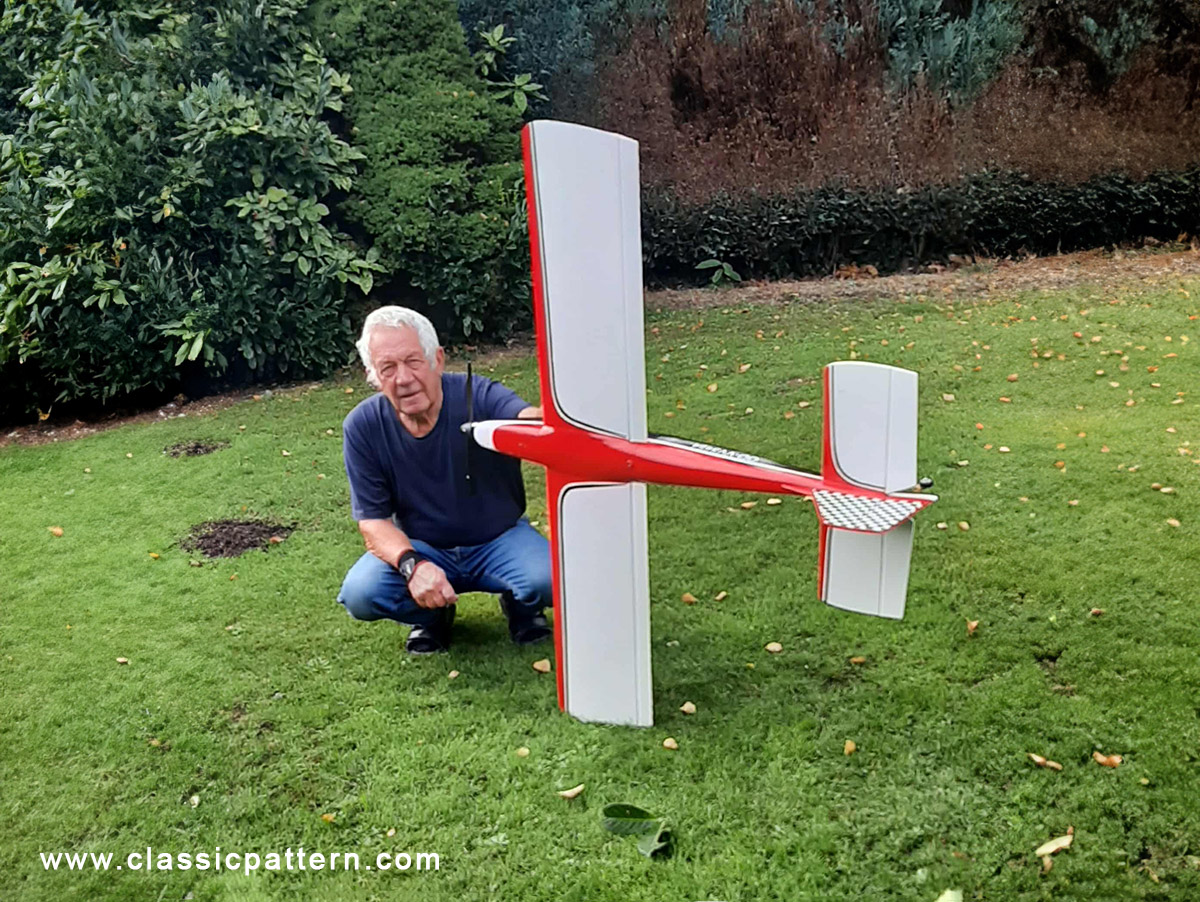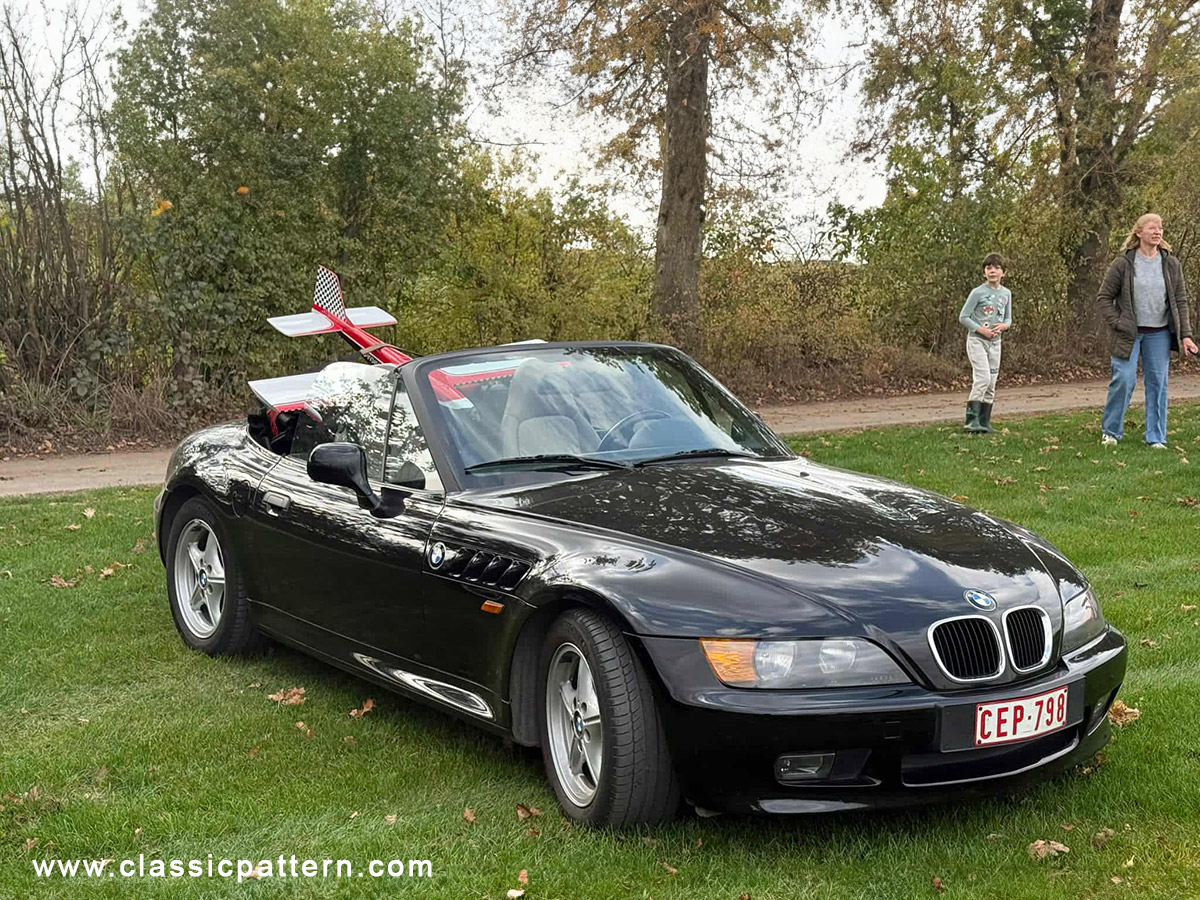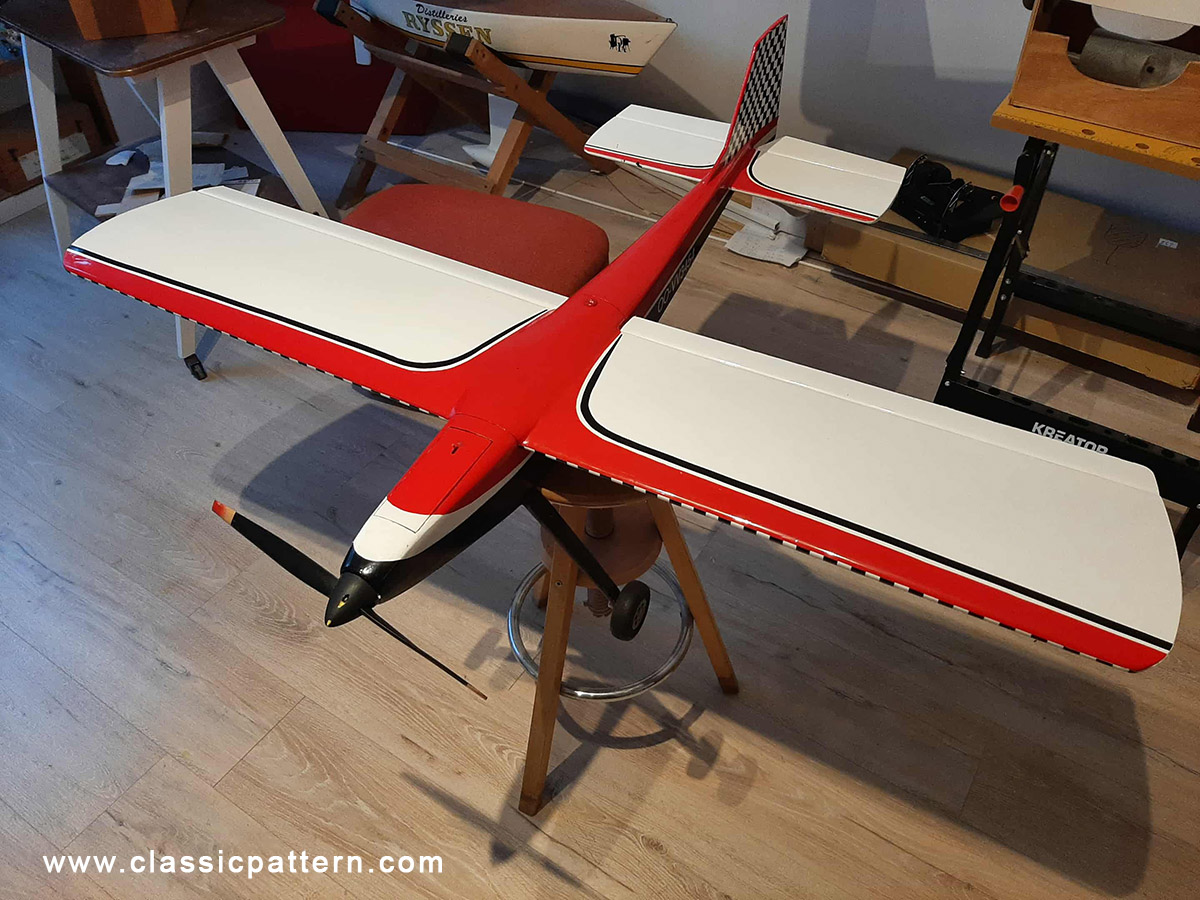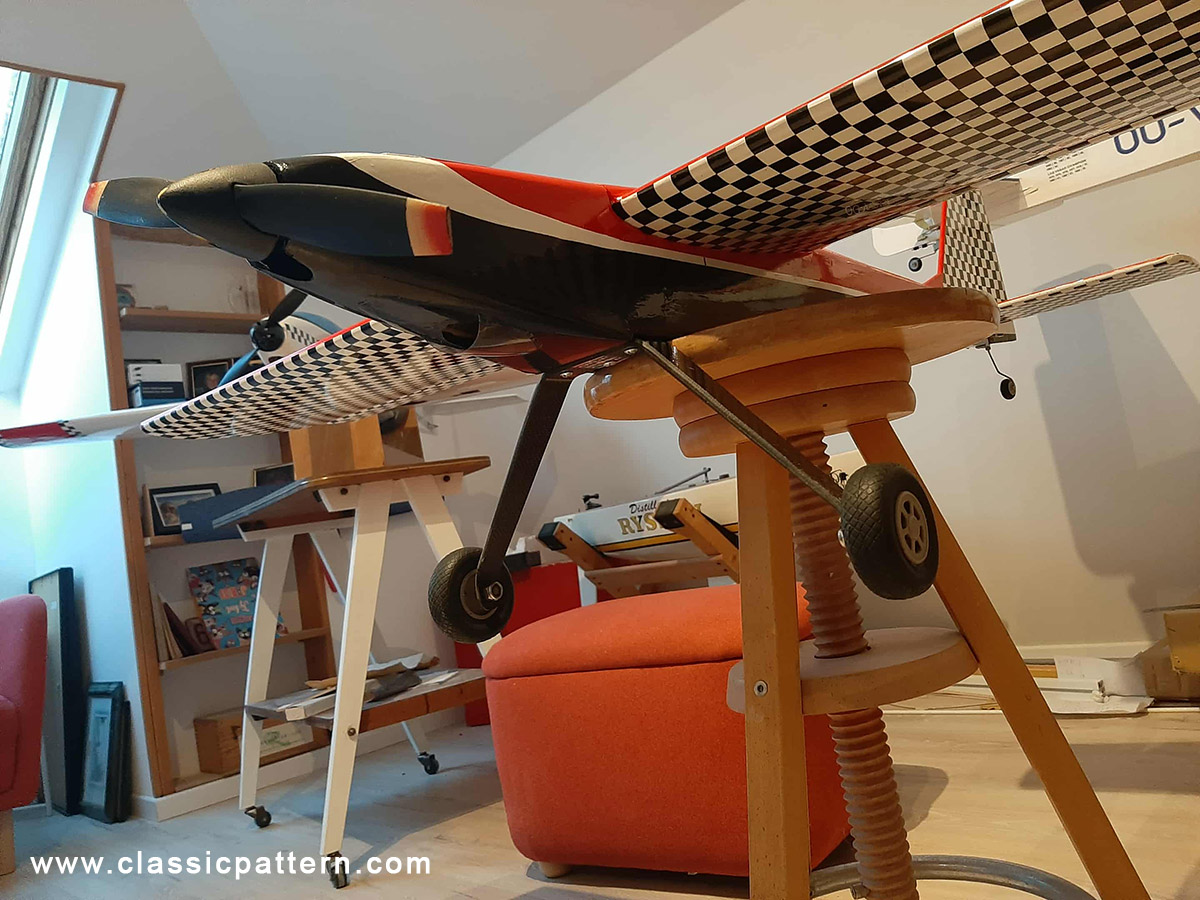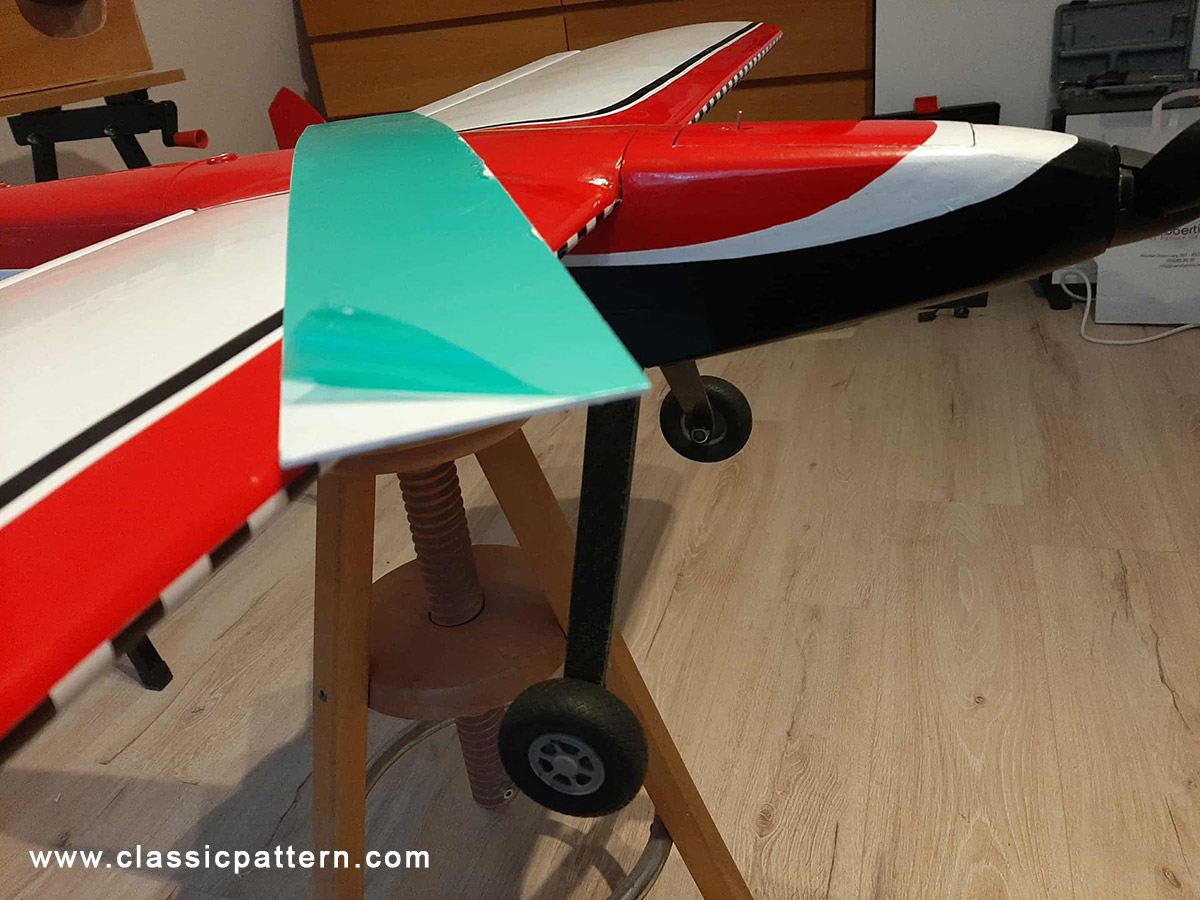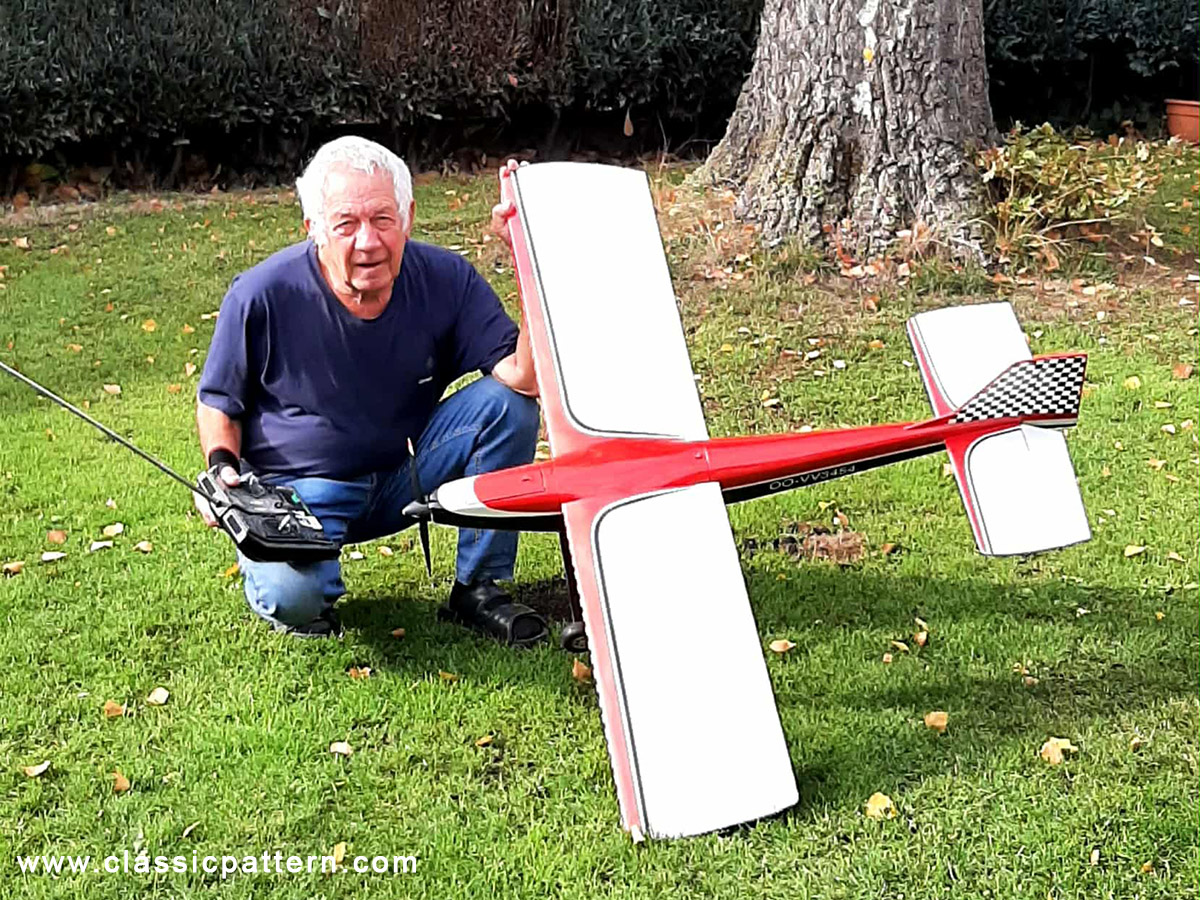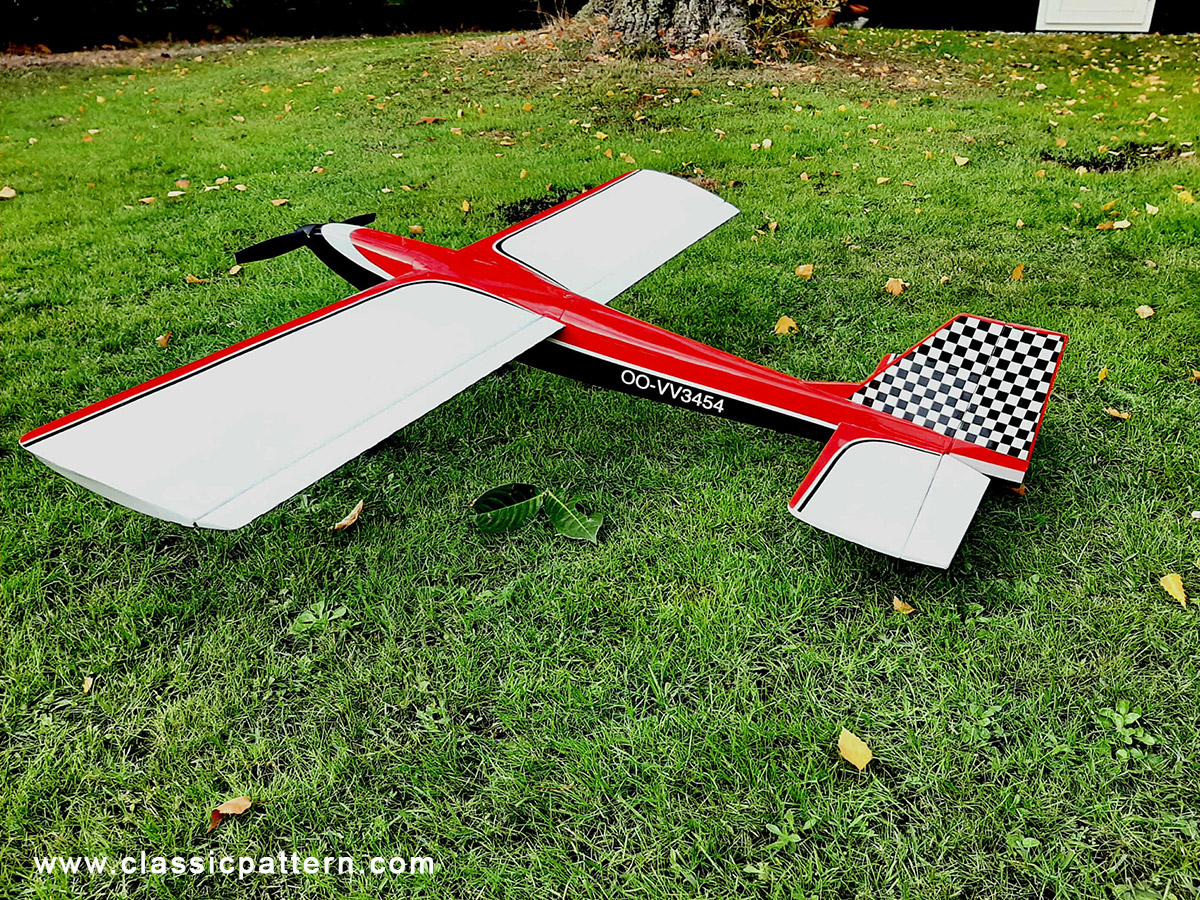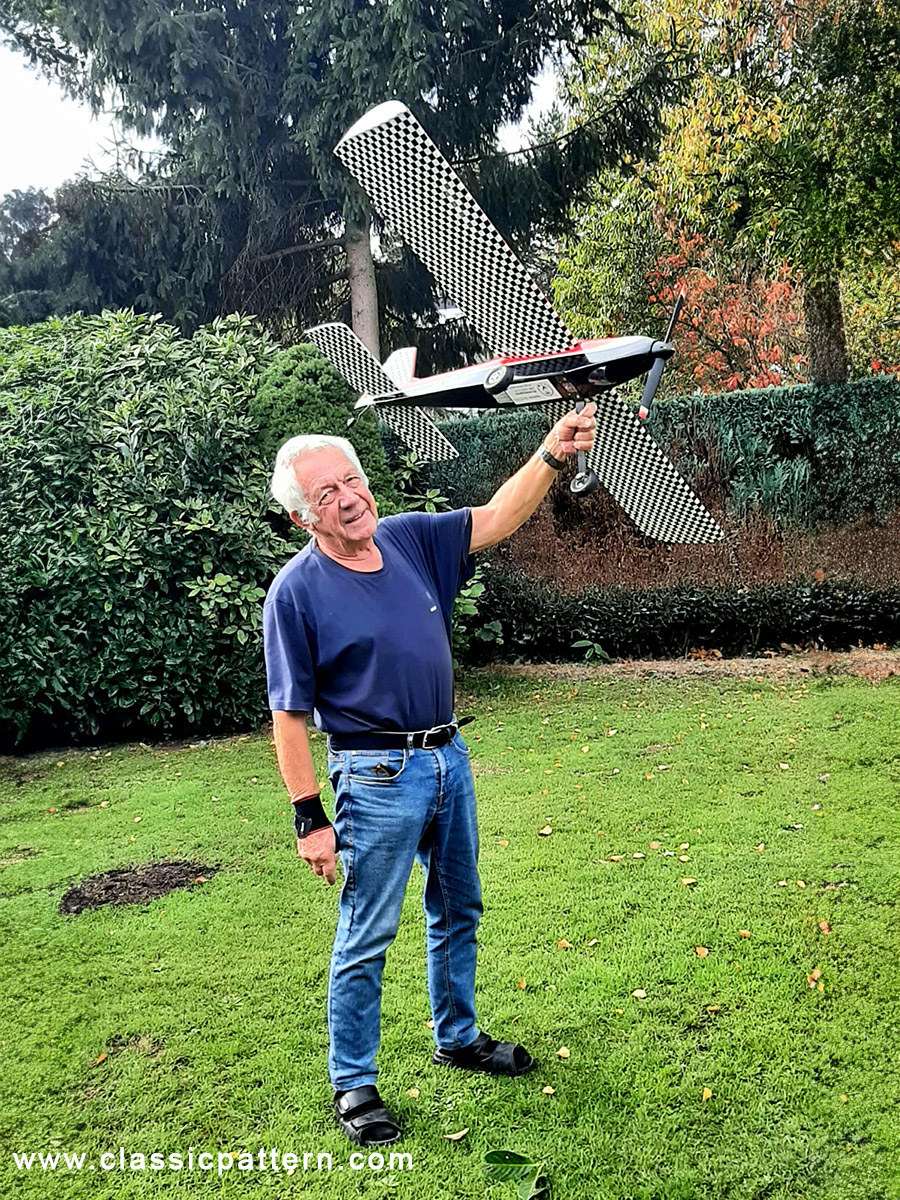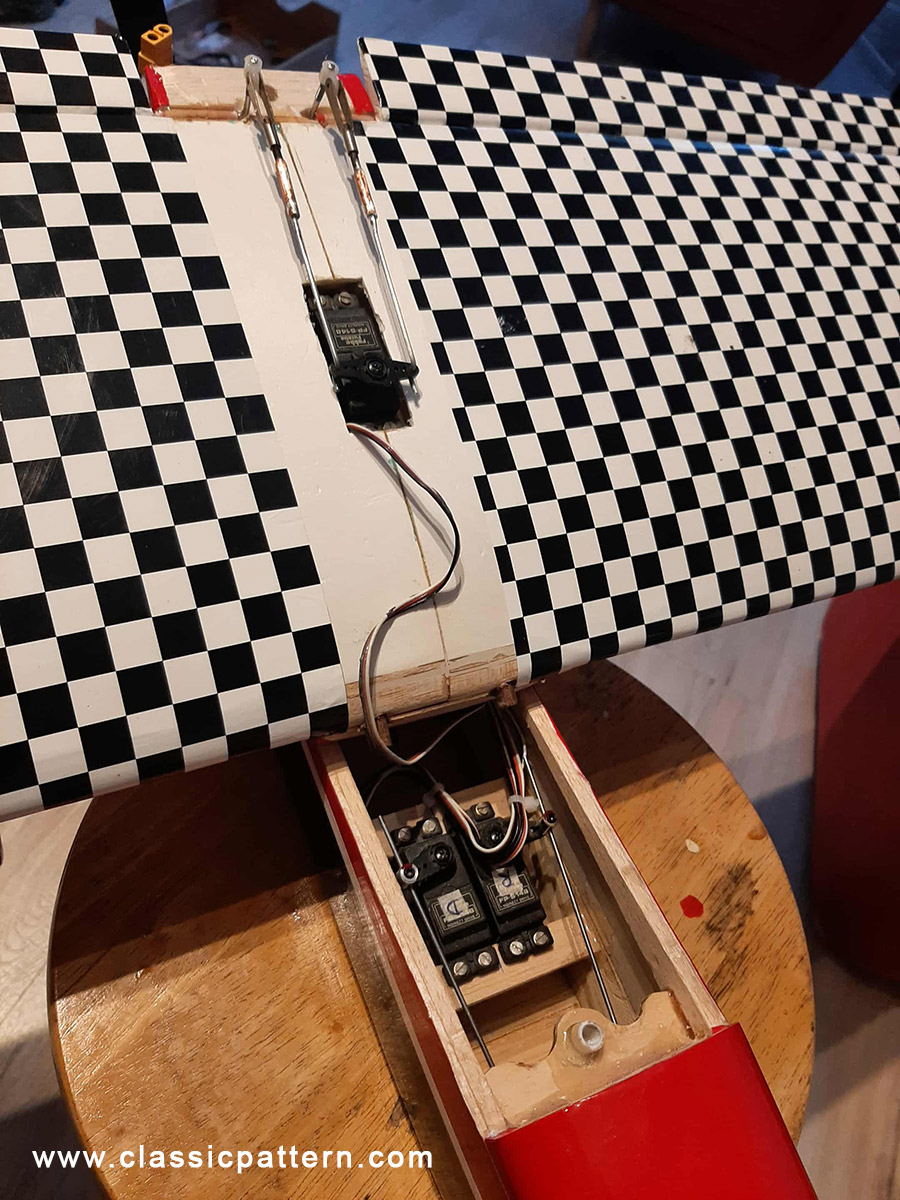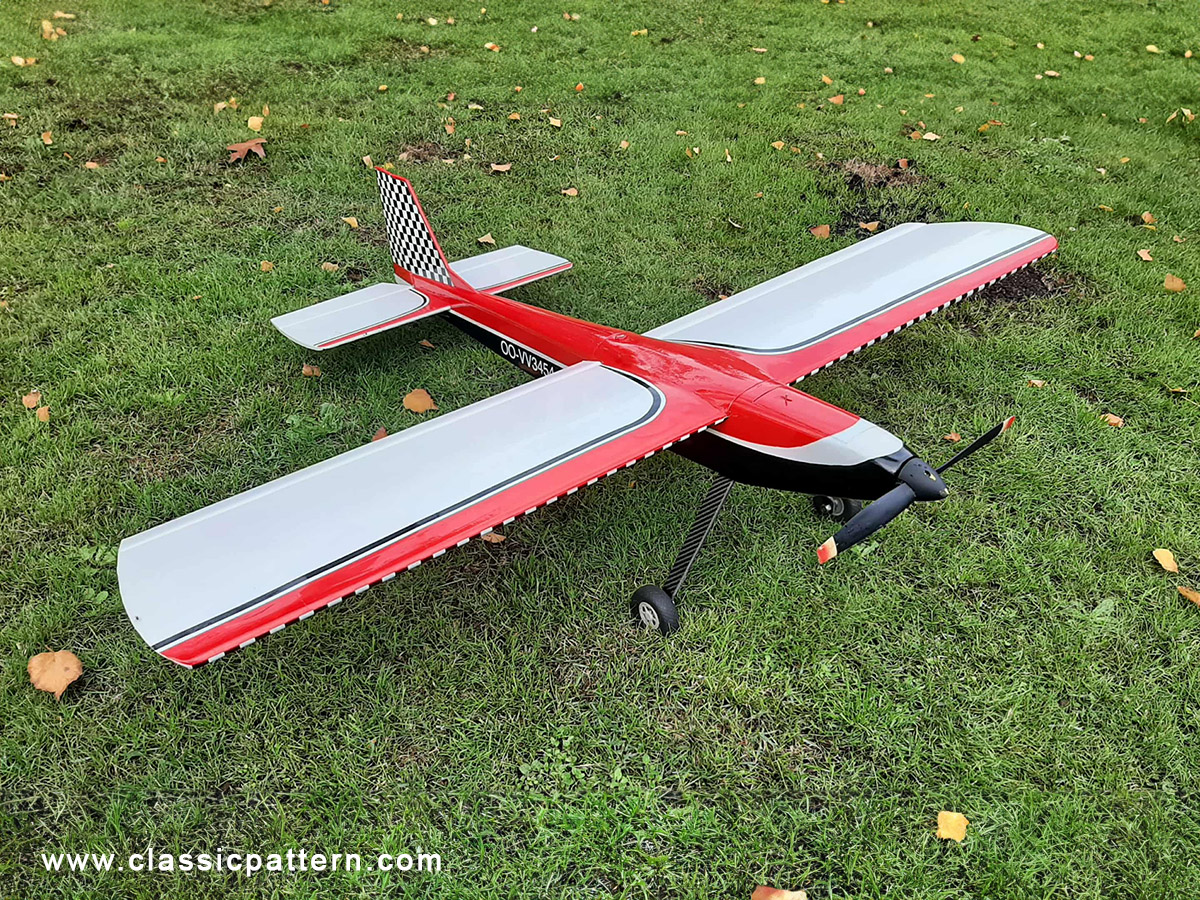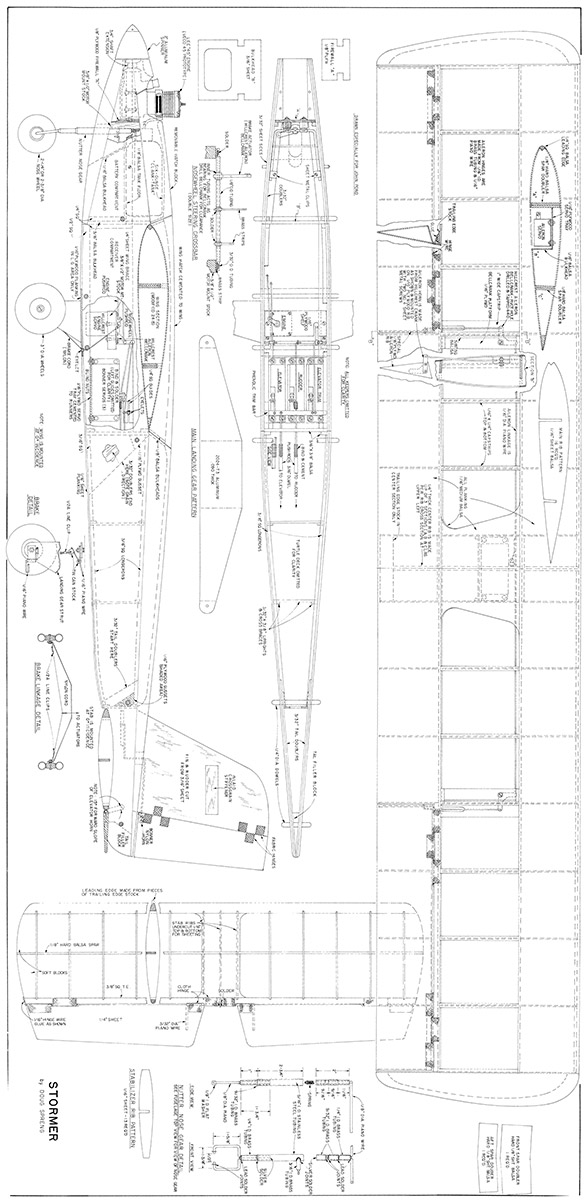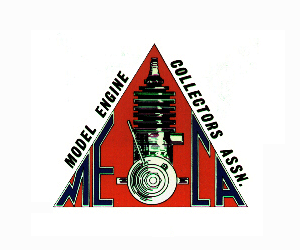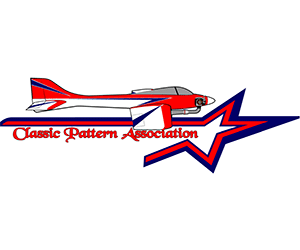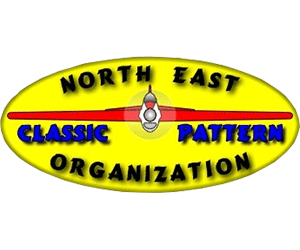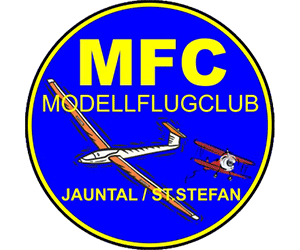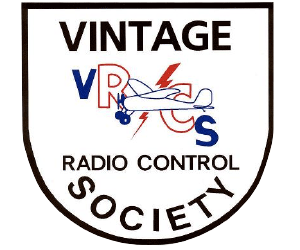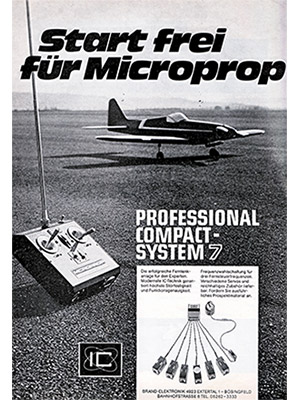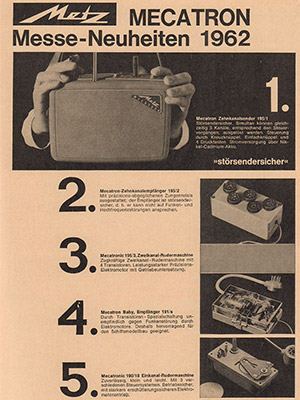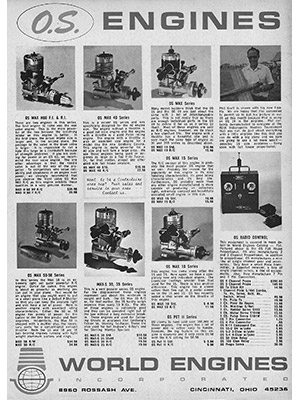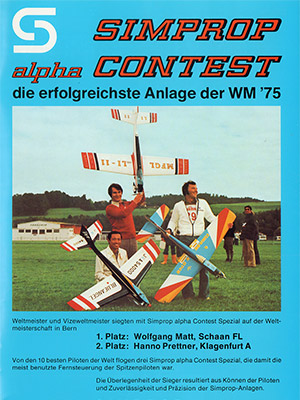Our Belgian colleague, Edward Vandermeulen, has struck again. His latest work is a scaled-down replica of the Doug Spreng Stormer construction from the early Sixties.
As I’m getting more and more nostalgic, I’m not a fan of modern F3A aeroplanes… sorry… they are boring… fly too slow… and are expensive…
Even at almost 80, I still live at 200 miles per hour.
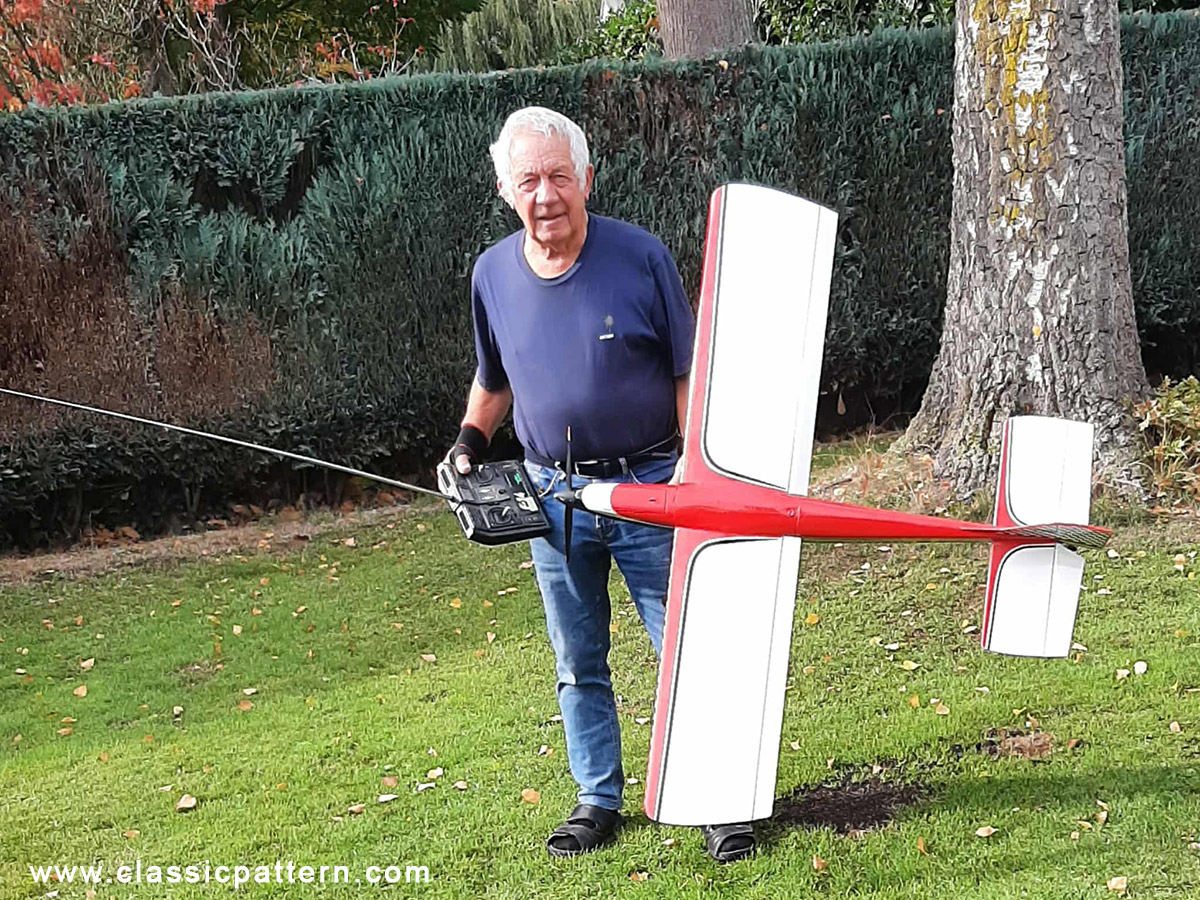
Doug Spreng’s STORMER was one of the best aerobatic aeroplanes of the 60s.
Out of nostalgia and because of the wonderful memories of this aeroplane, I wanted to rebuild it.
However, I wanted it to fit in my car without having to dismantle it.
So I printed out the plans from the Internet and added a factor of 0.8, giving me a wingspan of 1350 mm.
2 wheels instead of 3, the wing is made from cheap cardboard from the local shop.
This cardboard is usually used for gluing on pictures.
The design of the rudder was slightly shortened as I find the original ugly.
I kept the original colour scheme.
I fly it electrically with a 750kv and 4s 3000.
Hier der Original Artikel aus dem Magazin Aeromodeller April 1961:
DOUG SPRENG, America’s Best Multi-Class Radio Control Competition Flyer Takes You On Design Tour As He Describes His National Meet R/C Winner ‘STORMER’
“Stormer” is a return to the order style R/C jobs that ruled the roost before the present day plethora of low wingers took over “Multi” completely. But Stormer is a bit different—look it the zero-zero incidence set-up of the wing and stabilizer.
HIGH versus LOW
Come on, fellas, let’s face it! It is just plain easier to build, fly and maintain a shoulder wing model. We must also face the fact that a shoulder wing configuration is inherently more stable in the roll axis. Indubitably! The more stable a model is, the fewer correction commands need be sent; therefore the resulting flight is that much smoother. Now we are all familiar with the glaring need to keep correcting that ole dropping-wing tendency so characteristic of low-wingers. Somewhat akin to having to keep it balanced on the tip of the transmitter antenna. NUF SED!
We have a question from the balcony, Professor. No down or right thrust?
Right! None needed. The esteemed Charles Grant (and I) contend that an noffset engine is a gross waste of power.
A properly distributed lateral area is self-compensating to torque; hence no right thrust. The thrust line coincides with the center of drag, ergo no down thrust. It’s that simple! This is no “fluke” peculiar to one model only. Stormer’s design antecedent and Tour of Don Mathes’ “Gamblers” have been built along this line of thought.
And now some yakking about the tail group. You all know that Dr. Walt Good leaves the thickness of the elevators constant chordwise in his “Multi-Bug” design. The reason for this is so the elevators will be effective at very small angles of attack. Now Walt flies TTPW and I fly reeds. Therefore I taper the elevators to a fairly sharp trailing edge. You say it doesn’t make sense? Okay, put it another way.
In order to make a reed ship look smooth in the pitch axis during a maneuver, one must “blip” the elevators—that is pulse “up” for a large loop, etc. This means that if the elevators were sensitive near neutral, the slightest “blip” for up would make the model act like a kangaroo. But, fellow confused modelers, if the elevators were relatively insensitive around neutral, it would take more blips for a given looping radius. Therefore, the model would act smoother—the incremental changes in pitch attitude would be less noticeable. But if you haul back on the up lever and hold, Stormer will loop on the proverbial dime (and give a nickel change).
A lot of top fliers will take me to task for my reasoning along about now, but I say the proof is in the pudding. Howard McEntee summed it up beautifully in his column recently as he described the ’60 Nats. I quote him verbatim—”Furthermore, they (the judges) were placing more emphasis than is usual on smooth ness of flight, with the result that the top reed men were forced to fly their planes as though they were proportional jobs.”
You’ll say “Why not use less elevator’travel, such that full ‘up’ will give a large smooth loop?” I can only counter with the question, “Is there not a time when a tight looping radius is needed to get out of trouble dose to the ground?” and “Will the model true spin reliably with reduced elevator travel?” So much for all that jazz.
Also note that the stab is relatively thick with a sharp leading edge and rearward maximum thickness point. This also contributes to the groovy, smooth flight characteristics of Stormer. It is a funny thing, but al- most every model I have built has flown better,. especially in spins and rolls, after I added to the vertical stab area. Stormer was no exception. The silly-looking square rudder on my Nets model resulted from having to add more area at the “last moment”. This has been included in the plans,.
The thickness percentage of the wing has a direct bearing on the way a model flies. I have retained the 15% wing religiously. I see no reason for going thinner, as you gain nothing by thinning the wing. As a matter of fact, there are some distinct disadvantages. A thicker wing is stronger and yields more lift at higher wing loadings. A thicker wing will fly slower, and no one in his right mind should want to fly faster.
I have heard a cry from the troops that a faster model is smoother.
I say PHOOEY! A sharpened leading edge will do more to smooth out a model than brute speed. A faster model will hop and jerk when sent a small command. Hummingbirds are very fast, es birds go.
But have you seen how erratic and jerky their flight path really is? Only another hummingbird would appreciate the way they fly, much less a stunt judge at an R/C event!
Every thought and consideration has been made in arriving at Stormer’s configuration–smooth flying was the goal, but not by risking other desirable attributes. In the course of experimenting with Tour preceding models, it was learned that a thick wing section with a sharp leading edge in conjunction with large ailerons of small travel would be the Optimum in wing configuration.
Speaking of ailerons, I wasted no time nor gas journeying to the local airport to copy the most sophisticated ailerons that could be unearthed. I stuck with the reliable, proven, easy-to-use type. Let’s face it, men, when practice doesn’t agree with ivory-tower theory, it is time to junk the theory. Okay? Onward!
Down with the Reynolds Number! My point, if you are listening, is that the so called “Frise” ailerons can be likened to electronic flip-flop. They offer Bither maximum rolling torque or none. There is no aerodynamic “in between”. Lack inn is the gradual transition needed for smooth control in the roll axis. As far as landing gears go, tricycle types handle better on the ground in windy weather. Landing is a pure un adulterated pleasure. The nose gear I used at the Nats was designed by Date Nutter and is being manufactured by Perfection Model Co., 827 22nd St., Santa Monica, Calif. The mail-order price is $7.50 and it even comes chrome plated! What more could you want?
It is fully steerable and sprung in two directions. An internal spring takes the vertical shocks, and its torsion mounting allows longitudinal movement. The added flying fun and guarantee against nose overs makes it well worth the small weight penalty.
Let’s get on with construction. I usually start with the wing, es this is the hardest pärt for me to build. The wing of a Stormer goes together like an egg crate. I always slot and assemble the spars first, since it is easiest to get the dihedral angle exact at the beginning of things. One wing panel is assembled first, and when the cement is dry, the job is rocked over so the other panel can be worked on. Assemble the ribs on the spars first, then lay the assembly down on the 4″ sheet that forms the trailing edge. The front spar is shimmed up 3/16″ to compensate for the bottom camber curve. At this time cement in the plywood aileron rib (at Section B) and its balsa counterpart at the tip end of the aileron. Make sure the plywood aileron rib is set in far enough for the horn screw heads to clear the adjacent rib.
After sanding a slight bevel where the top and bottom sheeting meets at the trailing edge, add cement to all contact points and pin the top sheeting in place. Once’ the 1/4″ sq. leading edge is cemented in and the cement has dried well, the leading edge sheeting can be added to the top of the wing. The aileron bellcrank .platform and cap strips are ‘ added and the assembly allowed time to dry. Then the opposite panel can be built • up like the first. Once that portion has had the proper drying time, the assem bly is removed from the work area, flip ped over and work commenced on the bottom. The leading edge sheeting is applied carefully, as the wing can still, warp easily at this stage.
When the top and bottom sheeting is on, the assembled wing will be quite rigid, due to the enclosed box construction. Add all remaining cap strips and parts of the center rib at this time, before much more of the center section sheeting is added.
The servo platform is built into the center section, followed by the fitting and assembly of aileron linkage. Tips are shaped, hollowed and cemented on at this time. After the wing is finished and all cement is thoroughly dry, cut ailerons out with a Zone saw. Trim front of ailerons to angle shown and plank. Attach ailerons to wing with tubing and wire hinges as shown. The Hillcrest plastic piano hinge may also be used. Aileron movement should be 1-1/8″ up, 7/8″ down at the trailing edge, no more! The most critical part of the fuselage construction is getting everything absolutely straight. Great care must be taken in assembly, so there will be no twists or hidden thrust offsets. First, cut out the sides and doublers, then cement them together. Next, cut motor ‘mounts out of hardwood es per the top view and assemble to bulkheads “A” and “B”. Glue well! Model cement just won’t do here. I recommend Wilhold Glue, thinned slightly with water, es it then has more Chance to sink into the hardwood for a strong fuel proof bond.
When sides and doublers have dried (the cement, that is), join the sides and bulkhead-motor-mount assembly together. Then join sides together et tail. Add intermediate bulkheads. I carved the turtle-deck section of my model out of one piece of soft balsa that was tack-cemented to the fuselage. Every modeler has his pet technique, so let the chips fall where they may. You can plank the top instead of carving, if you want to spend some drafting time cooking up the necessary bulkheads. But keep the approximate weight and strength as close to the original plane as possible.
The rest of the model is of orthodox construction and non-critical, so go to it.
FLYING STORMER
It is important that a complete prefiight checkout be made before attempting the first flight. Here is your preflight checkout list, itemized for quick run-down.
- Check all surfaces for warps. Correct all warps before any flying is attempted.
- Assemble Stormer and check thrustline and angle of incidence of wing and stab. All to be zero-zero. THIS IS IMPORTANT! No right or left thrust offsets on engine. If you are flying Stormer with only 8 channels and have no trim elevator, you may use one degree of incidence in the wing, but NO MORE. (For Stormer’s 12″ chord, this means raising the leading edge about 3/8″ higher then shown on the plan.)
- Stormer should balance at 30 to 40% of chord. If it does not balance there, add ballast or shift equipment until it does. DO NOT attempt to correct an unbalanced condition with elevator trim.
- At the fiying field, suspend Stormer by rubber bands and check for vibration effects with the engine running at several different speeds.
Harmonie vibrations can be deadly. The first take-off should be made with a slight amount of “up” trim. Once airborne and at a safe altitude, trim Stormer out for flat and level flight.
Notice how “groovy” and smooth she flies. Also note how relatively insensitive she is to elevator around neutral. By blipping “up”, execute a large loop.
You will hardly notice the small incremental changes in pitch attitude as she flies through the loop. Now heul full “up” elevator and see how tight she will turn without any tendency to snap-roll.
Viva la 15% section! Si and Oui!
Specifications Doug Spreng’s Stormer:
Wingspan: 1,60 Meter
Length: 1,43 Meter
Flying weight 3,5 kg
Motor: Veco 45 Lee Customs
Specifications Edward Vandermeulen`s Stormer:
Wingspan: 1,33 Meter
Length: 1,14 Meter
Flying weight: 2,2 kg
Motor:Arrows RC #3541 750 kv brushless outrunner
Battery: 4S 3000 mAh
Now roll Stormer over on her back and apply just a slight tap of “down” trim. She will be just as groovy inverted as she is right side up. Landing Stormer with trike gear is pure pleasure. Just remember that Stormer is not prone to stall, and she’ll settle down in a ladylike manner. No vicious tricks. Landing will be made best with the tail low. If, however, you do try to bring her in “hot” and the nose wheel hits first, you might es well turn off the transmitter, because she’ll stop bouncing when she is darned good and ready.
Standard procedure is to use “up” trim and lose all flying speed, letting her settle nose high. In this attitude she will touch the main wheels first, then settle down onto the nose wheel without ‘even a hint of a bounce. The negative angle of attack at rest is important.
This assures that you won’t hit nose wheel first on landings, Tho it does necessitate “kicking” it off the ground during take-off with a very slight touch of “up” elevator.
Now the fun begins. Taxi back to the “hangar” and swing her around and apply the brakes (full “down” trim) and watch the spectators’ mouths fall agape.
Now that you have flown Stormer, would you go back to those old-fashioned, unstable Iow-wing monsters? Of course not.
Text: Edward Vandermeulen, Doug Spreng
Pictures: Edward Vandermeulen
Notes:
The original stormer had a rounded back.
When Doug crashed his first plane he build a second one with a flat back because it was easier to build.
Het named it the Flat top Stormer.
Because it was so ugly he put a cockpit on the wing panel.
Also his saying it flew as well



